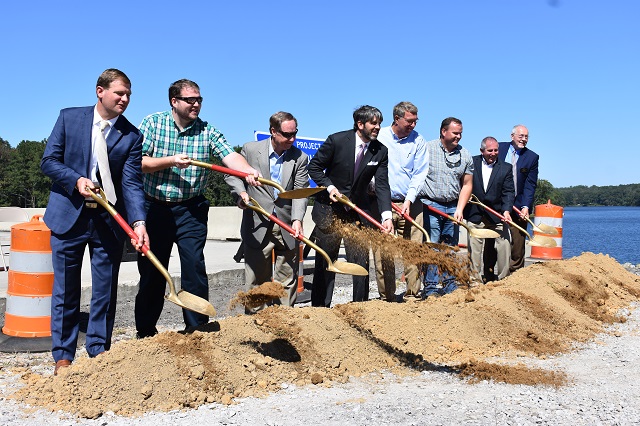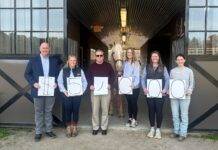
CULLMAN, Ala. – The Alabama Department of Transportation (ALDOT), City of Cullman, Cullman Economic Development Agency (CEDA) and Cullman County’s legislative delegation on Thursday morning “broke ground” to mark the official launch of the construction project that will finally complete the four-lane expansion of Alabama Highway 157- from just east of U.S. Highway 31 to just past Cullman Regional, the only portion of the 90-mile highway that does not already have four lanes.
ALDOT’s official project description reads, “For constructing the additional lanes (grading, drainage, pavement, ITS [Intelligent Transportation System], and traffic signals) on SR-157 from the junction of SR-69 to a point east of the junction of SR-3 (US-31) in Cullman. Length 4.245 mi.”
Officials involved in the ceremony included:
- Cullman Mayor Woody Jacobs
- ALDOT North Region Engineer Curtis Vincent
- Cullman Economic Development Agency Director Dale Greer
- Carrie Suggs, representing Sen. Richard Shelby, R-Alabama
- Paul Housel, representing Congressman Robert Aderholt, R-Alabama
- Kate Messervy, representing Sen. Doug Jones, D-Alabama
- Sen. Garlan Gudger, R-Cullman
- Rep. Randall Shedd, R-Fairview
- Rep. Corey Harbison, R-Good Hope
- Rep. Scott Stadthagen, R-Hartselle
Also in attendance were the Cullman City Council, CEDA’s Hwy. 157 project coordinator Jamie Troutman, Bill St. John- son of Finis St. John III who, as a state senator, helped start the Hwy. 157 expansion project many years ago- and representatives of Chilton Contractors, the company that will perform the construction.
Greer told the assembled audience, “We all can attest to the need for four lanes on this stretch of 157. It is congested in the mornings and evenings. Daily traffic count exceeds 16,500 within sight of where we are standing. It is one of the busiest roadways in Cullman County and the route Cullman Countians use to access the hospital and many of our health care providers. It is a critical east-west artery across the state.
“In December of 2018, the City of Cullman saw an opportunity and committed $1 million in local matching funds and applied for a $14 million United States Dept. of Transportation BUILD grant. Few people truly believed Cullman had much of a chance of receiving funding in the first-ever BUILD funding cycle. Over 800 applications were received from throughout the U.S.; 92 were awarded: two in Alabama and only 58 highway projects in America. The $14 million approved grant ranks as one of the largest in our history.
“Since then, the right-of-way acquisition, engineering, planning, utility relocation and bidding of the construction contract have occurred- much more activity than most people realize. It takes a team effort to make a project of this magnitude come to fruition. We had support from Governor Kay Ivey, John Cooper at ALDOT, our federal and state legislative delegations, and numerous other entities that needed this highway widening, including Cullman Regional, the ambulance service, police, fire, industries, Cullman schools and other municipalities.”
After recognizing officials in attendance, Greer continued, “The City of Cullman funding pledge jumpstarted the application. If not for their contribution and forward thinking, this project would not have occurred in the foreseeable future. They realized this project is desperately needed for the city of Cullman, Cullman County and the surrounding areas.
“Mayor Keith Henry of the Town of Fairview and Mayor R.D. Joslin of the City of Arab both provided letters of support for the grant. The Cullman Economic Development Agency staff worked on the grant and will continue to do the reporting for the entirety of the project. Terry Acuff with Community Consultants could not be here today, but he assisted the city economic development office and Jamie Troutman to complete a very in-depth application and cost benefit analysis. I have taken longer at the microphone than I intended, but we are proud there were so many contributors and supporters that helped us show we had a regional project.”
Vincent congratulated the City and said, “Any time something major like this happens, it’s not because of a lack of hard work,” noting the efforts of numerous entities from the city government to the legislative delegation.
Gudger shared, “This has been one of the most anticipated events in Cullman’s history. On behalf of myself, Representative Randal Shedd, Representative Corey Harbison and Representative Scott Stadthagen, your state delegation, we are honored to be here today and to take part in this monumental occasion. This project will improve safety and will provide a boost to our economy. The teamwork displayed to connect this final link of Alabama Hwy. 157 is not just an achievement for Cullman County, but for all of north Alabama.
“Cullman County is known to always have a vision and work earnestly to make that vision into a reality. The conception of this Hwy. 157 bypass started in the late 70s when Finis St. John III worked to secure funding for the project. He knew what it could do for the downtown area and economic development of the whole county. He was right, and I am honored to serve this district in the Senate, just as he did, and today to see the start of the final chapter of that vision unfold.
“This project will improve safety and will provide a boost to our economy. I have personally experienced the traffic issues and bumper-to-bumper times on this road. Four-laning this remaining portion of 157 will improve the quality of life for all people traveling along this corridor, from industries like Yutaka and Royal Technologies, first responders headed to CRMC, people trying to get to commercial businesses, people headed back and forth taking their children to school; everyone who utilizes this road will enjoy the fruits of many people and groups’ hard work for generations to come.
“Transportation infrastructure is one of the main components needed to support any community’s commercial, industrial and residential growth and its extended success. That is why federal funding, like the BUILD grant, and support of Rebuild Alabama is so important. Without adequate funding, projects like this for our community would cost local taxpayers millions. But with federal BUILD Grant and Rebuild Alabama, we are maximizing our local tax dollars to be spent for local roads, not state highways.
“I want to say thank you to Governor Kay Ivey for her support of this project and for making infrastructure a priority in Alabama. Also, to ALDOT Director John Cooper for working with the Cullman City Council and mayor to make this project a reality. I also want to thank our federal delegation, especially Senator Shelby, that supported this grant application and project. They knew this project was one that was desperately needed, and their support and persistence are extremely appreciated. This is a great day in Cullman and the state of Alabama.”
The project was expected to cost between $14,601,211 and $17,845,925, part of a total cost of more than $28 million, offset by a federal grant awarded to the City of Cullman. The construction contract was awarded to Chilton Contractors of Clanton in the amount of $14,895,273.05.
New devices for emergencies and speed control
In addition to base preparation, drainage and erosion control, paving and striping for the four-lane roadway, the project also includes specialized traffic signals to replace current signals at:
- Alabama Highway 69 intersection
- Hospital Drive (Cullman Regional) intersection
- Eva Road intersection
- Childhaven Road intersection
Additionally, a signal will be added at the Dahlke Drive intersection.
The new signals will include emergency vehicle preemption systems, which allow emergency responders to control the signals for faster and safer passage, at Dahlke Drive, Eva Road and Childhaven Road. Radar detection units will be installed with the new signals at all intersections.
City got federal grant to move project up list
In October 2018, ALDOT said the project was part of its five-year plan but specified that the timetable was contingent on the agency’s ability to procure the necessary funding. Cullman was able to move the project up on ALDOT’s schedule by applying for and receiving a $14 million federal grant through the U.S. Department of Transportation’s Better Utilizing Investment to Leverage Development (BUILD) program. The City received the grant in December 2018.
Mayor Jacobs said in his announcement of the grant that there were between 900 and 1,000 grant applications across the United States, and only 10% of those were awarded.
“This $14 million grant, to my knowledge, is the largest grant the City of Cullman has ever been awarded,” he said.
Jacobs talked about the importance of the project, especially concerning access to Cullman Regional. This two-lane portion of Hwy. 157 is the direct route to Cullman Regional, which serves more than 175,000 people in a six-county area. The current traffic congestion on this road makes it difficult at times for emergency vehicles to reach the hospital. More than 15,000 cars travel this two-lane section of road daily, which includes trucks trying to get from local industries to Interstate 65.
“Bridges to nowhere”
The “bridges to nowhere” in the 3.5-mile corridor, one over the railroad and one over Lake Catoma, were completed over two years, finished in 2013. Widening of the road was postponed indefinitely because of a lack of funding. The bridges have been the subject of much controversy among Cullman County residents, who have frequently voiced frustrations about the completed bridges being inaccessible.
Jacobs alluded to the “bridges to nowhere” nickname in his remarks, but noted, “Cullman could not have qualified for the 157 BUILD Grant if the bridges had not already been in place.”
The previous bridge construction by ALDOT and right-of-way acquisition by the highway department allowed the 157 widening to fit the requirement that grant applications must be “shovel ready” to qualify for funding.
In a previous interview, Jacobs said, “Poor old ALDOT took a whipping about these two bridges sitting out there cause they’re finished but not being utilized. Well let me tell you, without those two bridges, we could not have gotten this grant, because part of this grant process was it’s got to be a project that’s pretty well ready to go. Over 90% of the right-of-way of has already been acquired and the bridges are completed.”
Equipment needed to begin construction is already onsite at various points along the route. The project is expected to take 330 working days, or two calendar years, to complete.
Family legacy
The name of Sen. Finis St. John III has long been attached to the Hwy. 157 project and to the road itself. Though he passed away, his son Bill St. John attended the ceremony to represent his father and family.
St. John told The Tribune, “It’s an honor to us to still have my dad’s name on this road, and for this phase of the project to kind of bring it to completion. It’s a big deal for everybody in Cullman, and for us.”
Copyright 2020 Humble Roots, LLC. All Rights Reserved.






























